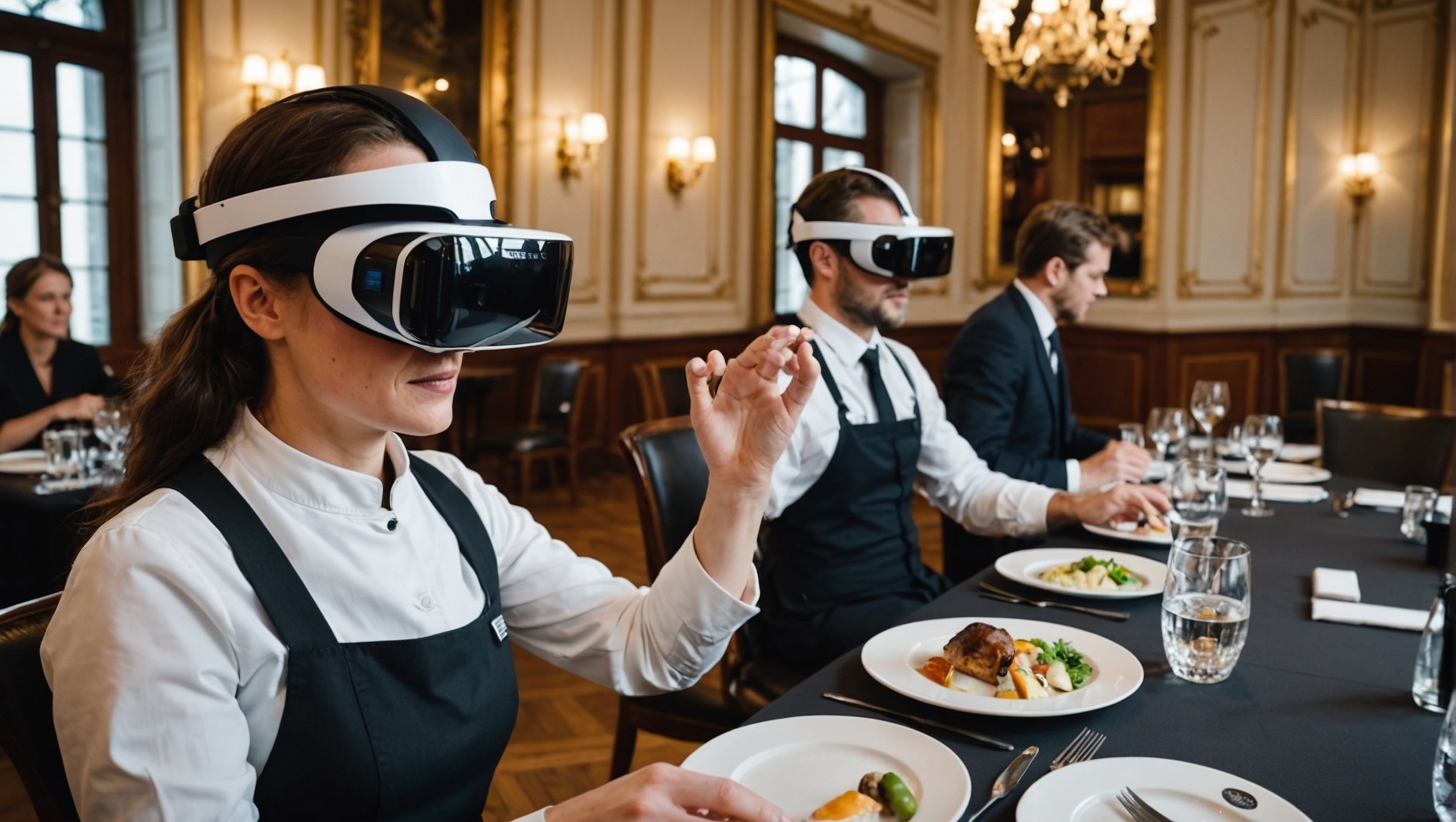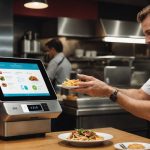Revolutionizing Fine Dining Staff Training: Harnessing Virtual Reality for Superior Learning Experiences
In the fast-evolving hospitality industry, the need for innovative and effective staff training methods has never been more pressing. One of the most promising technologies transforming the landscape of fine dining staff training is virtual reality (VR). This article delves into how VR is revolutionizing the way staff are trained, enhancing their skills, and ultimately improving the dining experience for customers.
The Evolution of Training in the Hospitality Industry
The hospitality industry has long relied on traditional training methods such as on-the-job training, workshops, and job shadowing. While these methods are effective, they have their limitations. For instance, on-the-job training can be risky and may impact actual service areas, while workshops may not provide the immersive experience needed for complex scenarios.
Also to see : Smart Strategies for Restaurants to Minimize Their Carbon Footprint
The introduction of VR and other digital technologies is changing this narrative. VR training offers a risk-free, immersive environment where staff can practice real-world scenarios without any consequences. This approach is particularly beneficial in fine dining, where the margin for error is minimal, and the need for precision and excellence is paramount.
How Virtual Reality Enhances Staff Training
Immersive Learning Experiences
VR training provides an unparalleled level of immersion, allowing staff to engage in realistic scenarios that mimic the actual dining environment. For example, a VR simulation can recreate a busy restaurant during peak hours, enabling trainees to practice managing tables, handling customer inquiries, and resolving conflicts in a controlled setting.
Have you seen this : Revolutionizing Inventory Management: Leveraging IoT Devices for Enhanced Efficiency in Multi-Location Restaurant Chains
- Simulate busy restaurant environments
- Practice managing tables and customer interactions
- Train on conflict resolution and problem-solving
- Enhance service skills in a risk-free environment
- Improve adaptability to different scenarios
Personalized and Adaptive Training
One of the significant advantages of VR training is its ability to be personalized and adaptive. Generative AI can be integrated into VR systems to create training simulations that adjust based on the staff member’s performance. This ensures that each trainee receives a tailored learning experience, addressing their specific strengths and weaknesses.
Real-Time Feedback and Assessment
VR training systems can provide immediate feedback and assessment, helping staff to identify areas for improvement. This real-time feedback is crucial for skill retention and ensures that staff are well-prepared for real-world situations. For instance, VR can be used to simulate a kitchen environment where trainees can practice cooking techniques and receive instant feedback on their performance.
Practical Applications of VR in Fine Dining
Front-of-House Training
VR can be used to train front-of-house staff in various aspects of customer service. Here are some practical applications:
- Greeting and seating customers
- Taking orders and managing tables
- Handling customer complaints and feedback
- Ensuring consistency in service standards
- Training on new menu items and promotions
For example, a VR simulation can place a trainee in a scenario where they have to manage a table of demanding customers. The trainee can practice their communication skills, problem-solving abilities, and service excellence in a realistic yet controlled environment.
Back-of-House Training
VR is also beneficial for back-of-house staff, particularly in the kitchen. Here are some ways VR can enhance kitchen operations:
- Training on new recipes and cooking techniques
- Practicing kitchen safety and hygiene protocols
- Managing kitchen workflows and order prioritization
- Enhancing plating and presentation skills
- Training on equipment operation and maintenance
A culinary school might use VR to simulate a restaurant kitchen, allowing students to manage every aspect from menu planning to food preparation, providing an immersive experiential learning experience.
Integration with Other Technologies
Augmented Reality and Machine Learning
While VR is a powerful tool on its own, its integration with other technologies like augmented reality (AR) and machine learning (ML) can further enhance the training experience. AR can be used for staff onboarding, allowing new employees to be trained in real-life situations before entering the actual work environment.
ML can be used to analyze data from VR training sessions, providing insights into staff performance and identifying areas that need improvement. This data analytics can help in creating more effective training programs and improving operational efficiency.
Benefits for the Hospitality Industry
Enhanced Customer Satisfaction
Well-trained staff are better equipped to handle customer interactions effectively, leading to improved customer satisfaction. VR training ensures that staff are prepared for various scenarios, reducing the likelihood of mistakes and enhancing the overall dining experience.
- Improved customer service skills
- Enhanced problem-solving abilities
- Consistent service standards
- Increased customer satisfaction
- Positive reviews and increased sales
Operational Efficiency
VR training can also improve operational efficiency by reducing the time and resources needed for traditional training methods. It allows staff to practice and perfect their skills in a virtual environment, reducing the risk of errors in real-world settings.
- Reduced training time and costs
- Improved staff performance and efficiency
- Enhanced operational efficiency
- Better resource allocation
- Reduced employee turnover
Real-World Examples and Success Stories
Several establishments in the hospitality industry have already seen the benefits of VR training. For instance, the École hôtelière de Lausanne (EHL) uses VR for their Virtual Housekeeping class, providing a more interactive and complete learning environment.
Another example is the use of VR in restaurant chains to train staff on new menu items and service protocols. This approach has led to improved consistency in service and food quality, resulting in higher customer satisfaction and positive reviews.
Practical Insights and Actionable Advice
Implementing VR Training
For those looking to implement VR training, here are some practical insights:
- Start with a clear objective: Define what skills or scenarios you want to train staff on.
- Choose the right VR platform: Select a platform that is user-friendly and tailored to your needs.
- Integrate with existing training programs: Combine VR with other training methods for a comprehensive approach.
- Provide ongoing support: Ensure that staff have access to VR training regularly to reinforce their skills.
- Monitor and evaluate: Use data analytics to assess the effectiveness of VR training and make necessary adjustments.
Overcoming Challenges
While VR training offers numerous benefits, there are also challenges to consider:
- Initial investment: VR equipment and software can be costly.
- Technical issues: Ensure that the VR system is reliable and free from technical glitches.
- Staff resistance: Some staff may be hesitant to adopt new technology; provide adequate training and support.
- Content creation: Develop high-quality, relevant content that aligns with your training objectives.
The integration of VR into fine dining staff training is a game-changer for the hospitality industry. It offers immersive, personalized, and adaptive learning experiences that enhance staff skills and improve operational efficiency. As the industry continues to evolve, embracing innovative technologies like VR will be crucial for maintaining high standards of customer service and dining experiences.
In the words of a hospitality industry expert, “VR training is not just about simulating real-world scenarios; it’s about creating a culture of continuous learning and improvement. It’s about empowering staff to provide exceptional service and ensuring that every customer interaction is memorable and satisfying.”
As we move forward, it’s clear that VR will play a pivotal role in shaping the future of staff training in the hospitality industry. By harnessing this technology, fine dining establishments can ensure that their staff are equipped with the skills and knowledge needed to deliver superior customer experiences, driving customer satisfaction, loyalty, and ultimately, business success.






